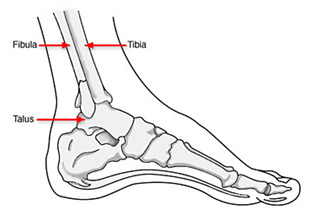-
Non-Weight Bearing Medical Conditions
- < go back to the Learning Center
- A wide variety of injuries and medical conditions require patients to avoid placing any weight on their injured foot or ankle during recovery.
- Knee walkers are medical devices specifically designed for below the knee conditions to allow patients greater mobility around their home or office during the non-weight bearing recovery period. A knee scooter is an invaluable tool which keeps you in an upright position and mobile so you can maintain your lifestyle. We have a variety of knee walker models for sale and rent to meet everyone's specifications.
- Listed below are some common medical conditions and injuries that require a non-weight bearing recovery period.

Swivelmate Knee Walker- The material appearing on this page is for informational use only. It should not be used as a substitute for professional medical advice, diagnosis or treatment. Rent A Knee Walker assumes no responsibility for this content, nor endorses, or guarantees any claim/fact or opinion.
-
Broken Ankle Recovery
- Content Source: American Academy of Orthopaedic Surgeons Read full article here
Broken Ankle
"I broke my ankle." A broken ankle is also known as an ankle "fracture." This means that one or more of the bones that make up the ankle joint are separated into pieces. There may be ligaments damaged as well.- Simply put, the more bones that are broken, the more unstable the ankle becomes.
- Cause
- •
- "Twisting" or rotating your ankle
- •
- "Rolled" your ankle
- •
- Tripping or falling
- •
- Impact during a car accident
- Since there is such a wide range of injuries, there is also a wide range of how people heal after their injury.
- Broken ankles affect all ages. Ankle fractures occur in 184 per 100,000 persons per year. During the past 30 to 40 years, doctors have noted an increase in the number and severity of broken ankles, due in part to an active, older population of "baby boomers." In 2003, nearly 1.2 million people visited emergency rooms because of ankle problems.
- Anatomy

- Three bones make up the ankle joint
- •
- Tibia ("shin bone")
- •
- Fibula (small bone on the outside of your ankle)
- •
- Talus (a foot bone)
Anatomy of the ankle- Three bones make up the ankle joint
- •
- The tibia and fibula have specific parts that make up the ankle:
- Medial malleolus: Inside part of the tibia
- Posterior malleolus: Back part of the tibia
- Lateral malleolus: End of the fibula
Symptoms
Because a severe ankle sprain can feel the same as a broken ankle, every ankle injury should be evaluated by a physician.- Common complaints for a broken ankle include:
- •
- Immediate and severe pain
- •
- Swelling
- •
- Bruising
- •
- Tender to touch
- •
- Cannot put any weight on the injured foot
- •
- Deformity ("out of place"), particularly if the ankle joint is dislocated as well
Diagnosis
Besides a physical exam, X-rays are the most common way to evaluate an injured ankle. X-rays may be taken of the leg, ankle, and foot to make sure nothing else is injured.- Depending on the type of ankle fracture, the doctor may put pressure on the ankle and take a special X-ray, called a "stress test." This X-ray is done to see if certain ankle fractures require surgery. Sometimes, a computed tomography (CT, or CAT) scan is done to further evaluate ankle injuries. For some ankle fractures, magnetic resonance imaging (MRI) may be done to evaluate the ankle ligaments.
Rehabilitation
Rehabilitation is very important regardless of how an ankle fracture is treated. It can take at least six weeks for the broken bones to heal. It may take longer for the involved ligaments and tendons to heal.- When your physician allows you to start moving your ankle, physical therapy and home exercise programs are very important. Doing your exercises regularly is key.
- Eventually, you will also start doing strengthening exercises. It may take several months for the muscles around your ankle to get strong enough for you to walk without a limp and to return to your regular activities.
Weight Bearing
Your specific fracture determines when you can start putting weight on your ankle. Your physician will allow you to start putting weight on your ankle when he or she feels your injury is stable enough to do so.- It is very important to not put weight on your ankle until your physician says you can. If you put weight on the injured ankle too early, the fracture fragments may move or your surgery may fail and you may have to start over.
- It is very common to have several different kinds of things to wear on the injured ankle, depending on the injury. Initially, most ankle fractures are placed in a splint to protect your ankle and allow for the swelling to go down. After that, you may be put into a cast or removable brace. Even after the fracture has healed, your physician may recommend wearing an ankle brace for several months while you are doing sporting activities.
- The material appearing on this page is for informational use only. It should not be used as a substitute for professional medical advice, diagnosis or treatment. Rent A Knee Walker assumes no responsibility for this content, nor endorses, or guarantees any claim/fact or opinion.
- < go back to the Learning Center
-
- Contact Us
- Call or Email Us - We're Here To Help
- Need help? Call us at 877 520 3708
- Monday - Friday 9:00AM to 6:00PM EST
- Email us:
-
- Current Events:
- Photo Contest
- The Grand Prize of $100 will be awarded to the best knee walker photo. Enter photo contest here
-
-
- Go to mobile website
- Privacy Policy | Terms & Conditions | Trademarks
Affiliate Marketing Disclosure | Site Map - * Monday through Friday, Except holidays and weekends.
- † New orders only, for orders totaling $100 or more, offer not combinable.
- All Rights Reserved ® 2007-2025 / Copyright © 2007-2025 Rent A Knee Walker
-

Looking for knee scooters in the UK? StrideOn is our sister company in the UK, dealing with all things knee scooter related. Rentals, accessories and more.